For
over a hundred years from 1850 or even before, the very word
'hell' was not acceptable in polite society beyond the pulpit.
Even in the pulpit the word was generally avoided, except by
'low church' sects and preachers. Hell and sex were almost equally
taboo.
Perhaps
the most famous comment now about Satan's Kingdom of the Nether
Regions is from Sartre - "Hell is other people".
topographically
it has varied from a place where one froze for a while to a
place where one perpetually burned. The ancient Egyptian hell
was a very vague place which nobody actually went to, because
certain easy rituals were designed to avoid it. The Dis of the
Greeks - the realm of the great god Hades - was truly dismal,
damp and dark, with souls flitting about like grey shadows,
while the Inferno of the High Middle Ages was a multi-level
hetero-universe of fires, devils and great noise: a Satanic
mill more horrendous even than those brought into being by the
English "Industrial Revolution" 600 years later, more
appalling even than the concentration-camps of Nazi Germany.
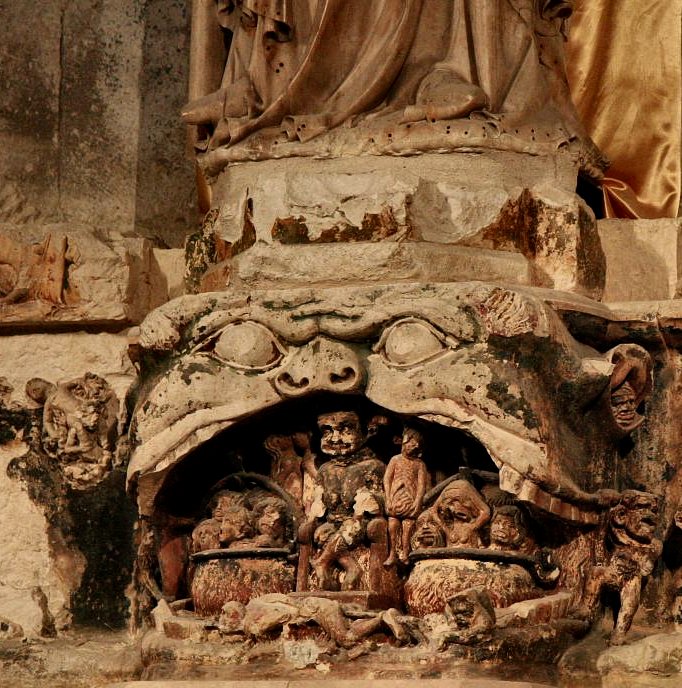
Christ
as conqueror stands squashing the head of Satan, whose open
mouth displays the damned,
including a monk - Narbonne cathedral (Aude).
click
to see more of the Narbonne Hell
In
the antique world, hell was not perceived as a real threat until
the formulation of Christianity. During
the time between the last books of the Old Testament and the
writing of Matthew's gospel, circa 250 BC
- 50 AD, there was an upsurge in Judæo-Christian
belief of an actual, perhaps immanent, place - Gehenna:
the burning rubbish-dumps outside Jerusalem, in a place
where children were once sacrificed. This is the place referred
to in the gospels.
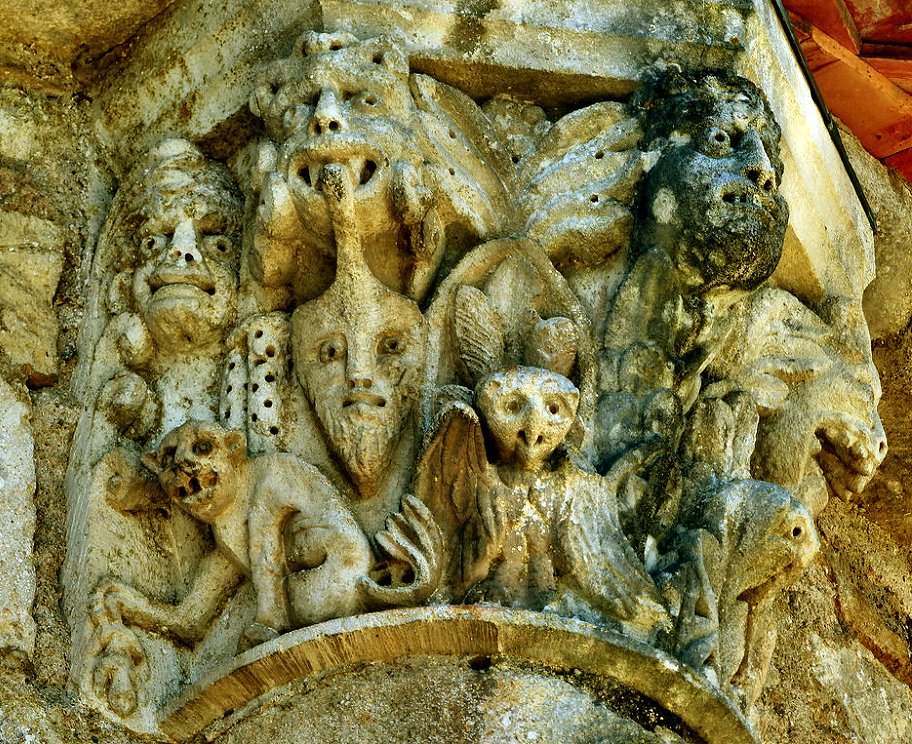
Hell
- full of monsters - at La Celle (Cher), France.
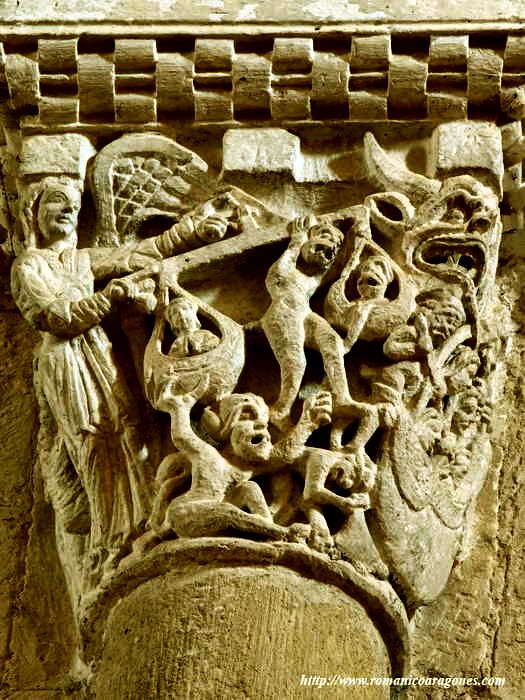
Fuentidueña (Segóvia),
Spain: The Archangel Michael is weighing souls (performing Psychostasia),
while Demons interfere.
But
the concept was vague. Then, around the 4th century, world-wide
and amongst many of the main non-polytheistic religions - Christianity,
Judaism, Buddhism and Taoism - there was suddenly an astonishing
growth in graphic depictions of hell - some with a reigning
devil (Shaitan, Satan, etc.), some without.
These
depictions were very detailed, with specific tortures allocated
and adapted to specific crimes: if you had ever looked lustfully
at a woman you would have your eyes pecked out in hell; if you
had been a glutton your liver would be picked out as the vulture
devoured Prometheus' liver every night; if you had done false
dealings your hands would be cut off and the stumps then dipped
in molten lead, again and again eternally.
These
wildly-inventive imaginings moved away from the basic conception
of hell as a place or condition to be saved from, to a titillating
scenario that developed pornographically in all major religions,
but especially in Western Christianity.
Ourense, Galicia: A full-colour, almost
baroque Romanesque depiction of the Last Judgement,
with a very realistic Luxuria centre-right and a male figure
beset by snakes above her.
Below her is a hanged moneybags.
photograph by Martin M. Miles.

Satan, from
the Last Judgement in the Scrovegni Chapel, by Giotto
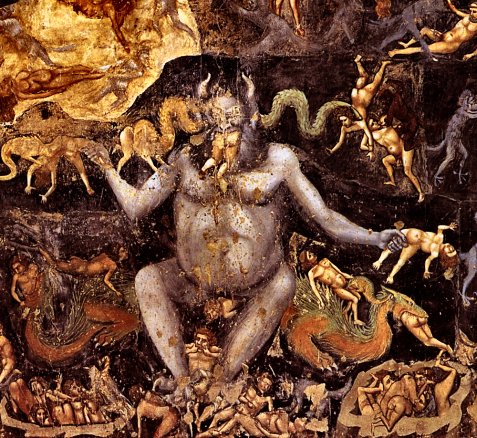
An earlier
Satan, from the Last Judgement mosaic
on the ceiling of the Baptistery of St John, Florence.
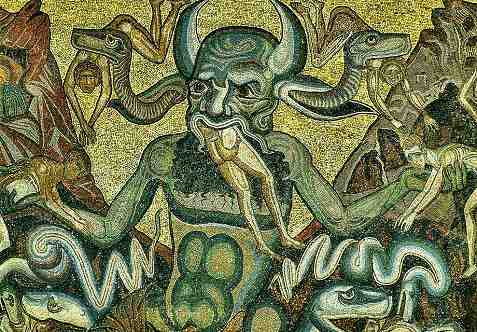
click
to enlarge
Something
which the big cults had in common, beyond the sudden blossoming
of graphic detail amongst their depictions of hell, was the
common theme of the story of a journey going down into the Underworld.
In Zoroastrianism there is the journey of Arda Viraf, who was
in many ways the prototype of all the later stories of journeying
through hell or hells.
This
story was enormously popular in the Middle East for 1000 years
but it is difficult to date exactly, estimated at around 150-200
AD. After this came the Apocalypse of Paul (or Visio
Sancti Pauli) -a story which was almost included in the
New Testament, appearing in it early on, but excluded by about
500 AD.
It
describes an dramatic, truly epic journey down into hell where
all the various scenes and layers of the infernal regions are
depicted. This story almost certainly shaped Dante's horrific
work describing a ghastly factory of unspeakable torture, and,
because it was thought to have been written by the Apostle Paul,
it carried considerable authority.
Of
course, hell is much more interesting than heaven, and the eyes
of visitors to Angkor Wat and Conques alike are not drawn to
the boring raptures of the blessed, but to the torments of the
wicked.
In mediæval Western Europe there was a parallel concept
of the ladder which led up to Heaven, with Jesus helping the
well-intentioned to climb it. Those who fell (or jumped) off
the ladder tumbled into hell. In the Orthodox community, however,
hell remains as vague and unimportant as in ancient Greece.
In
the West the idea of hell was used partly as a threat, partly
as a source of income. In the terrible Lateran Council of 1215,
one of the many cynical or insane doctrines promulgated was
that hell was perpetual punishment for temporal misdeed, and
one could not be rescued from it except by papal indulgence
- a conveniently-purchasable ticket against which Martin Luther
so successfully revolted.
The
whole of post-Romanesque mediæval art is tainted by this
doctrine dreamed up by febrile imaginations of theologians,
who, however, coolly admitted that the chief (or only ?) entertainment
in heaven could be the eternal and voyeuristic joy of watching
the tortures of the damned - who, it should be pointed out,
were naked.
This
echoes Jean Genet's observation that there would be no good
guys without bad guys, no Chief Constables without shoplifters.
By
thinking constantly about evil, people tend, contrary to their
conscious intentions, to create occasions for evil to occur.
Holiness became, in the 13th century, an irreversible and nasty
(and to some, very lucrative) business.
The
fires of hell were, of course, burning madly during that most
psychopathic of all periods of Christianity: the burning of
tens of thousands of "witches", "heretics"
and Jews across that Western Europe which today preaches tolerance
and "democracy". Mediæval thologians would have
pointed out that the truest democracy is hell, overseen by its
president-for-eternity, Lucifer, the fallen angel.

Jews
being boiled, wearing only the hats they were forced to wear
on earth -
from the Hortus Deliciarum, a late 12th century manuscript composed
in Alsace.
Click to see the whole page.

Sinners,
not
Jewish,
being boiled in Hell. Girona
Cloisters, 12th century.
Hell is always down, in earth, while heaven is always up somewhere
in the sky. In Buddhism it is Sudhana who goes down into the
hells, and in Islam there are accounts of the Prophet Mohammed
going down into the hells as a counterpoint to his journey up
to heaven from Jerusalem. In Chinese Taoism, hell is described
as an Earth Prison - revealing a theme which runs through
all faiths except perhaps Christianity: the notion that hell
is somewhere where souls are held until they have paid off their
debt of guilt and sin so that they may be released either into
heaven or into purgatory.
Christians,
on the other hand, can stay there forever - though Roman Catholics
believe that a soul can be raised up from hell by the intercession
of saints through prayer.
As is evident in this website, the Romanesque 'shorthand' for
eternal damnation was the gaping and toothy mouth of the beast:
the jaws of hell.
On
famous tympana (Conques, Beaulieu-sur-Dordogne) and friezes
(Lincoln) the committers of actual sins are portrayed repeating
them in hell and being punished by devils. But in Anglo-Saxon
(11th century) art the most common infernal depiction is the
Harrowing of Hell, mentioned in the Apostles' Creed:
"Christ
descended into hell and on the third day he rose again".
In the picture below, from the 12th century Winchester Bible,
filling the bottom of the letter B, the Harrowing of
Hell is on the right.
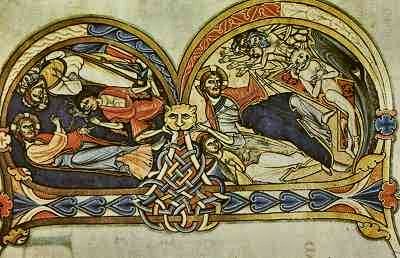
The
mythology of the harrowing of hell is Christianity's grappling
with the question of where Christ went when he died. It is the
only picture that the Orthodox Church will show of the resurrection.
According to the story, Christ breaks down the gates of hell
which form the shape of the baptismal font and he brings light
and joy into hell. Christ raises Adam and all the just men of
the past, regardless of what they have done, and leads them
into paradise.
He
raises Eve, and all the just women of the past, regardless of
what they have done, and brings them to paradise. Christ is
then forced to leave hell when Satan complains to God that his
realm is being invaded, rather as the Americans invaded Iraq...

![]()

![]() 'O
pale Galilean, the world has grown grey with thy breath!'
'O
pale Galilean, the world has grown grey with thy breath!'![]()
![]() -
Swinburne
-
Swinburne